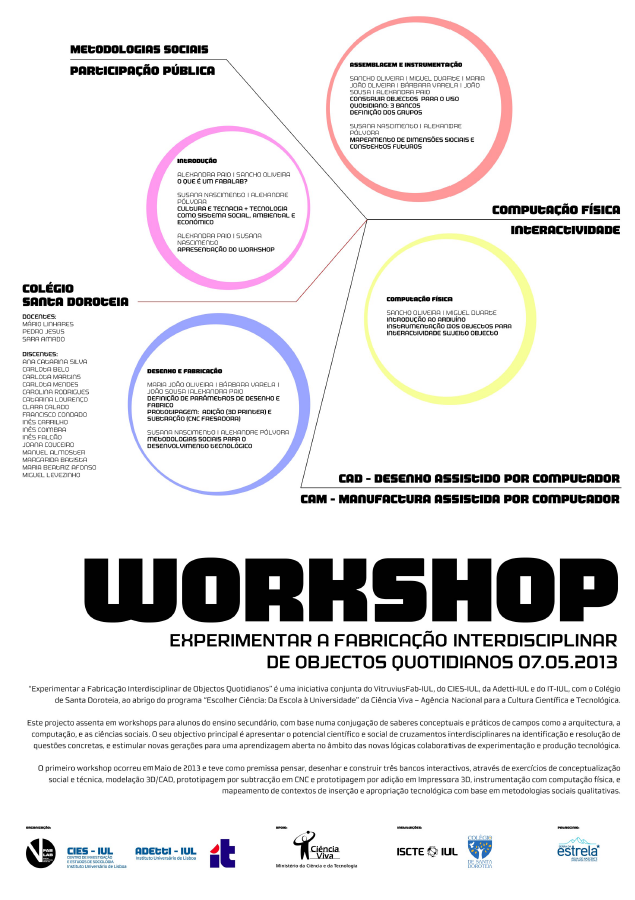Musical Morphogenesis
Musical Morphogenesis (2014-2017)
The interactive installation “Musical Morphogenesis” is a multidisciplinary project based on 5 main disciplines: computational biology, music, architecture, robotics, and science communication. The implementation of all components of the installation had to take into consideration the specificities of each discipline, turning this into an extremely challenging project. The main objective of “Musical Morphogenesis” was to take the visitors in a sensorial journey to explore the dynamic interactions of genes and proteins during the development of an organ. Such biological processes are highly complex, and the same set of genes can originate different organs depending on when they are activated. Taking advantage of a mathematical model that address the genetic network of the Arabidopsis thaliana flowers, a team of computational biologists, musicians, architects, engineers and science communicators joined hands to create an installation that could explore the development of flowers. The installation was composed of a robotic wood-made flower, which kinetics reflected the progression of the genetic network, and of an interface to interact with the installation. Visitors could turn on or off one or more genes, and eventually switch the network towards the formation of a different organ originating a mutant. To facilitate the comprehension of the network, each gene had a specific sound.
Project Information
2014-01-01
2017-12-31
Project Partners
- ISTAR-IUL (DLS)
- DINAMIA'CET-Iscte (CT)
- Calouste Gulbenkian Foundation - (Portugal)
- FABLAB-IUL - (Portugal)
- Gulbenkian Science Institute - (Portugal)
Experiment the Interdisciplinary Fabrication of Everyday Objects
“Experimenting with the Interdisciplinary Manufacturing of Everyday Objects” is an initiative coordinated by Alexandra Paio and Susana Nascimento at ISCTE-IUL Instituto Universitário de Lisboa, through the research and teaching units ofVitruviusFabLab-IUL, ADETTI-IUL and CIES-IUL, in partnership with the Colégio de Santa Doroteia. Ciência Viva - National Agency for Scientific and Technological Culture funded the project in the framework of the program “Choosing Science: From School to University” which aims to bring secondary and higher education closer, with a view to sharing resources and to encourage the pursuit of studies in scientific and technological areas.
This project is based on Workshops for secondary school students, based on a combination of conceptual and practical knowledge from fields such as Architecture, Informatics, and Social Sciences, and a privileged focus on the fields of digital fabrication, physical computing and social and qualitative methodologies. Its main objective is to present the scientific and social potential of interdisciplinary intersections in the identification and resolution of concrete issues, and to stimulate new generations for open learning within the scope of new collaborative logics of experimentation and technological production.
Project Information
2013-01-01
2014-08-31
Project Partners
Living System (2012)
Interactive Architecture is a processes-oriented guide to creating dynamic spaces and objects capable of performing a range of pragmatic and humanistic functions. These complex physical interactions are made possible by the creative fusion of embedded computation (intelligence) with a physical, tangible counterpart (kinetics). A uniquely twenty-first century toolbox and skill set-virtual and physical modeling, sensor technology, CNC fabrication, prototyping, and robotics-necessitates collaboration across many diverse scientific and art-based communities. Interactive Architecture includes contributions from the worlds of architecture, industrial design, computer programming, engineering, and physical computing. These remarkable projects run the gamut in size and complexity. Full-scale built examples include a house in Colorado that programs itself by observing the lifestyle of the inhabitants, and then learns to anticipate and accommodate their needs. Interactive Architecture examines this vanguard movement from all sides, including its sociological and psychological implications as well as its potentially beneficial environmental impact. Interactive Architecture by Michael Fox and Miles Kemp, 2009:20 “If living systems are machines, that they are physical auto poetic machines is trivially obvious: they transform matter into themselves in a manner such that the product of their operation is their own organization. However, we deem the converse as also true: A physical system if autopoetic is living. In other words, we claim that the notion of autopoiesis is necessary and sufficient to characterize the organization of living systems.” Autopoiesis and cognition: the realization of the living by Humberto R. Maturana and Francisco J. Varela, 1979:17. LS_01: Arduino +Grasshopper+Firefly and Prototyping (32 hours) 7th to 11th March 2012, D0.04 Laboratory (ISCTE-IUL, Building II) 7th and 8th March 2012 (Wednesday and Thursday) 18:30 -22:30 (4 hours) Trainers: Brimet Silva e...
Project Information
2012-01-01
2018-12-31
Project Partners
- ISTAR-IUL (DLS)
- DINAMIA'CET-Iscte
- Vitruvius FABLAB-IUL - (Portugal)
- FabLab EDP - (Portugal)
- Rhino 3D Portugal - (Portugal)
Avaliação e diagnóstico das necessidades de intervenção em edifícios nos bairros do Condado e dos Lóios em Marvila
Project Information
2010-05-10
2011-03-22
Project Partners

 Português
Português


